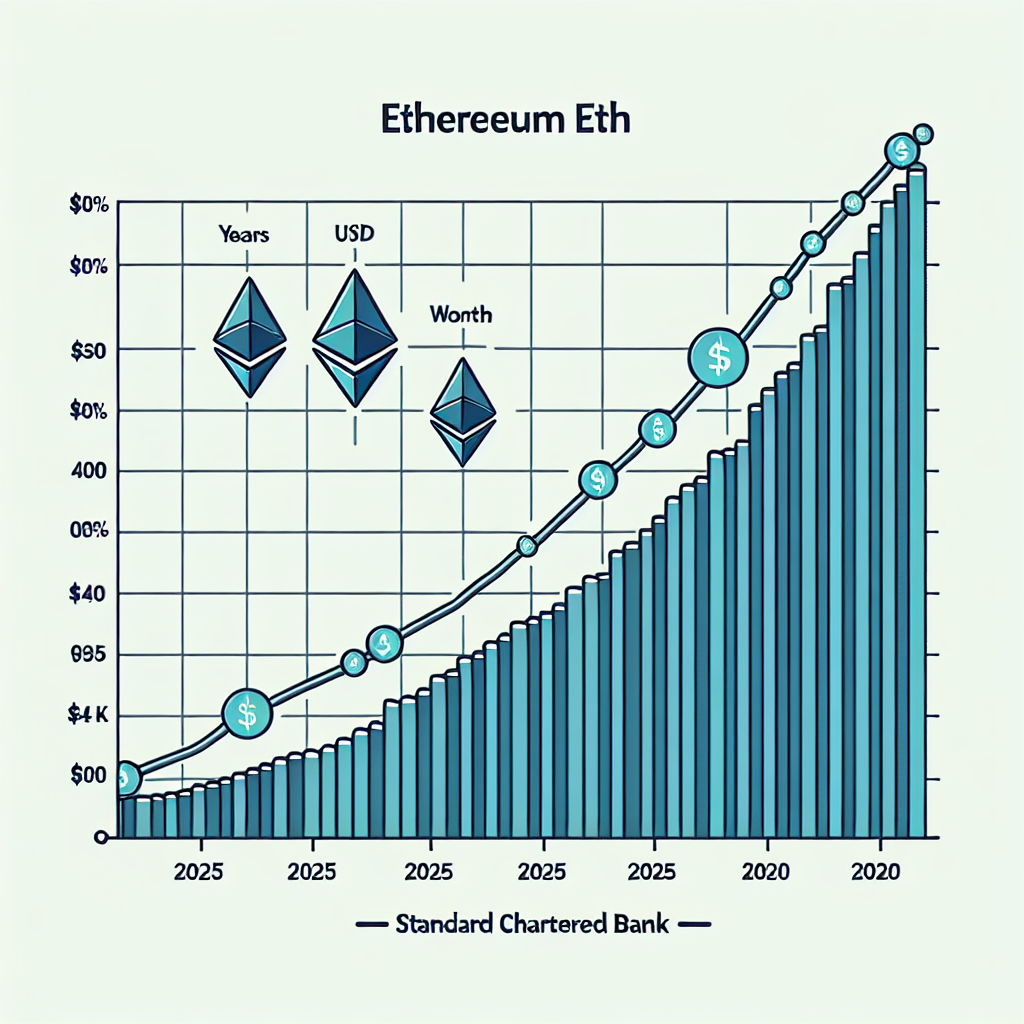
Factors Behind Standard Chartered’s Revised 2025 Ethereum Price Forecast
Standard Chartered’s recent decision to significantly lower its Ethereum (ETH) price forecast for 2025 from $10,000 to $4,000 has sparked considerable discussion among investors and market analysts. This substantial 60% reduction reflects a reassessment of several critical factors influencing Ethereum’s long-term valuation prospects. Understanding the rationale behind this revised forecast requires examining the broader economic environment, regulatory developments, technological advancements, and market sentiment shifts that have collectively shaped Standard Chartered’s updated outlook.
One of the primary factors contributing to Standard Chartered’s downward revision is the evolving macroeconomic landscape. Persistent inflationary pressures, coupled with central banks’ sustained commitment to higher interest rates, have dampened investor appetite for riskier assets, including cryptocurrencies. Ethereum, despite its prominence and widespread adoption, remains vulnerable to broader market volatility and investor caution. As interest rates remain elevated, investors increasingly favor traditional, lower-risk assets, thereby limiting capital inflows into Ethereum and other digital currencies. Consequently, Standard Chartered anticipates that macroeconomic headwinds will continue to exert downward pressure on Ethereum’s price trajectory through 2025.
In addition to macroeconomic considerations, regulatory uncertainty has emerged as a significant factor influencing Ethereum’s valuation outlook. Over the past year, regulatory scrutiny of cryptocurrencies has intensified globally, with authorities in major markets such as the United States, Europe, and Asia implementing stricter oversight measures. The lack of clear regulatory frameworks and the potential for stringent compliance requirements have introduced considerable uncertainty into the cryptocurrency market. Ethereum, as a leading blockchain platform supporting decentralized finance (DeFi) and smart contract applications, faces particular scrutiny due to its central role in facilitating complex financial transactions. Standard Chartered’s revised forecast reflects concerns that ongoing regulatory challenges could hinder Ethereum’s growth potential and limit widespread institutional adoption.
Furthermore, technological developments within the Ethereum ecosystem have also influenced Standard Chartered’s updated price projection. While Ethereum’s transition from proof-of-work (PoW) to proof-of-stake (PoS) through the Merge upgrade was successfully completed, subsequent network upgrades and scalability improvements have encountered delays and technical hurdles. The slower-than-anticipated progress in implementing critical enhancements, such as sharding and layer-two scaling solutions, has tempered expectations regarding Ethereum’s ability to rapidly scale and accommodate increased transaction volumes. Standard Chartered’s revised forecast acknowledges these technological challenges, recognizing that delays in achieving scalability and efficiency improvements could constrain Ethereum’s competitive advantage relative to rival blockchain platforms.
Market sentiment and investor confidence represent additional factors shaping Standard Chartered’s revised Ethereum price outlook. Following the cryptocurrency market downturn in 2022, investor sentiment has remained cautious, with many market participants adopting a more conservative stance toward digital assets. The collapse of prominent crypto exchanges and lending platforms, coupled with high-profile security breaches and fraud incidents, has further eroded investor trust. This cautious sentiment has translated into reduced trading volumes and diminished speculative interest in Ethereum, prompting Standard Chartered to adopt a more conservative stance regarding Ethereum’s future price appreciation.
In conclusion, Standard Chartered’s decision to lower its 2025 Ethereum price forecast to $4,000 reflects a comprehensive reassessment of macroeconomic conditions, regulatory uncertainties, technological progress, and market sentiment. While Ethereum remains a leading blockchain platform with significant long-term potential, these combined factors have prompted Standard Chartered to adopt a more cautious outlook. Investors and market participants should closely monitor developments in these key areas, as they will continue to shape Ethereum’s valuation trajectory in the coming years.
Market Implications of Standard Chartered’s 60% Cut in ETH Price Prediction to $4K

Standard Chartered’s recent decision to significantly reduce its Ethereum (ETH) price forecast for 2025 from $10,000 to $4,000 has sent ripples through the cryptocurrency market, prompting investors and analysts alike to reassess their expectations. This substantial 60% downward revision reflects a cautious reassessment of Ethereum’s growth trajectory, influenced by evolving market dynamics, regulatory uncertainties, and macroeconomic factors.
The immediate market implication of Standard Chartered’s revised forecast is a potential dampening of investor sentiment toward Ethereum. Investors who previously anticipated robust growth based on optimistic projections may now adopt a more conservative stance, leading to reduced buying pressure and possibly increased volatility in ETH prices. Such a shift in sentiment could temporarily stall Ethereum’s upward momentum, as market participants recalibrate their investment strategies in response to the lowered expectations.
Moreover, Standard Chartered’s revised estimate underscores broader concerns regarding regulatory developments in the cryptocurrency space. Regulatory scrutiny has intensified globally, with authorities increasingly focused on digital assets’ compliance, transparency, and investor protection. Ethereum, as one of the leading cryptocurrencies, is particularly susceptible to regulatory shifts, given its widespread adoption and central role in decentralized finance (DeFi) and smart contract applications. Investors may interpret Standard Chartered’s cautious stance as indicative of heightened regulatory risks, prompting them to reassess their exposure to Ethereum and related digital assets.
In addition to regulatory considerations, macroeconomic factors have also contributed to Standard Chartered’s revised outlook. Persistent inflationary pressures, rising interest rates, and geopolitical uncertainties have collectively dampened investor appetite for riskier assets, including cryptocurrencies. Ethereum, despite its technological promise and widespread adoption, remains vulnerable to broader market sentiment shifts. As investors increasingly prioritize stability and risk mitigation, Ethereum’s price trajectory may experience headwinds, aligning more closely with Standard Chartered’s tempered expectations.
Furthermore, the revised forecast may influence institutional investment flows into Ethereum. Institutional investors, who often rely on reputable financial institutions’ analyses and forecasts, may reconsider their allocation strategies in response to Standard Chartered’s updated projection. A reduction in institutional inflows could limit Ethereum’s liquidity and market depth, potentially exacerbating price volatility and constraining its growth potential in the near term.
However, it is important to recognize that Standard Chartered’s revised forecast, while significant, does not necessarily indicate a fundamental weakening of Ethereum’s underlying technology or long-term potential. Ethereum continues to play a pivotal role in blockchain innovation, supporting a diverse ecosystem of decentralized applications, non-fungible tokens (NFTs), and DeFi platforms. The network’s ongoing transition to Ethereum 2.0, aimed at enhancing scalability, security, and sustainability, remains a critical factor that could positively influence its long-term valuation.
Ultimately, Standard Chartered’s decision to lower its ETH price prediction serves as a timely reminder of the inherent volatility and uncertainty within the cryptocurrency market. Investors must remain vigilant, carefully evaluating both short-term market signals and long-term technological developments. While the revised forecast may temporarily dampen enthusiasm, Ethereum’s fundamental strengths and continued innovation suggest that its long-term prospects remain robust, albeit tempered by current market realities.
How Investors Should Respond to Standard Chartered’s Lowered Ethereum Valuation for 2025
Standard Chartered’s recent decision to significantly lower its Ethereum (ETH) price forecast for 2025 from $10,000 to $4,000 has understandably caused concern among investors. This substantial 60% reduction in valuation reflects shifting market dynamics, regulatory uncertainties, and evolving investor sentiment. Given this revised outlook, investors must carefully reassess their strategies and expectations regarding Ethereum and the broader cryptocurrency market.
Firstly, investors should approach this revised valuation with a balanced perspective. While the reduction is substantial, it is important to recognize that a $4,000 price target still represents considerable growth potential from Ethereum’s current market levels. Investors should avoid panic-driven decisions and instead evaluate the underlying reasons behind Standard Chartered’s adjustment. The bank’s revised forecast likely incorporates factors such as increased regulatory scrutiny, macroeconomic uncertainties, and intensified competition from alternative blockchain platforms. Understanding these factors can help investors better gauge the long-term viability and resilience of Ethereum as an investment.
Moreover, investors should consider diversifying their cryptocurrency portfolios to mitigate potential risks associated with Ethereum’s revised valuation. Diversification across multiple digital assets can help reduce exposure to volatility in any single cryptocurrency. For instance, allocating investments across established cryptocurrencies such as Bitcoin, as well as promising altcoins with strong fundamentals, can provide a more balanced risk profile. Additionally, investors may consider allocating a portion of their portfolios to traditional asset classes, such as equities, bonds, or commodities, to further enhance diversification and stability.
In addition to diversification, investors should closely monitor regulatory developments that could significantly impact Ethereum’s future valuation. Regulatory clarity or uncertainty can profoundly influence investor confidence and market dynamics. Recent regulatory actions in major markets, including the United States and Europe, have highlighted the importance of compliance and transparency within the cryptocurrency sector. Investors should remain informed about evolving regulatory frameworks and be prepared to adjust their investment strategies accordingly. Staying abreast of regulatory developments can help investors anticipate potential market shifts and make informed decisions.
Furthermore, investors should evaluate Ethereum’s fundamental strengths and weaknesses in light of Standard Chartered’s revised forecast. Ethereum remains a leading blockchain platform, widely recognized for its robust smart contract capabilities, decentralized finance (DeFi) ecosystem, and growing adoption in various industries. However, challenges such as scalability issues, high transaction fees, and competition from emerging blockchain networks could impact Ethereum’s long-term growth trajectory. Investors should carefully assess Ethereum’s ongoing technological upgrades, such as the transition to Ethereum 2.0 and the implementation of layer-two scaling solutions, to determine whether these developments adequately address existing challenges and support sustainable growth.
Finally, investors should maintain a long-term perspective when evaluating Ethereum’s revised valuation. Cryptocurrency markets are inherently volatile, and short-term price fluctuations should not overshadow the potential for long-term growth and innovation. Investors who remain patient, disciplined, and focused on fundamental analysis are better positioned to navigate market uncertainties and capitalize on future opportunities. By adopting a measured approach, investors can effectively respond to Standard Chartered’s lowered Ethereum valuation and make informed decisions that align with their investment objectives and risk tolerance.
![Ultimate Guide to the [Mind of Pepe ($MIND)] Token Sale: How to Participate and Key Insights](https://autocryptonews.com/wp-content/uploads/2025/04/トークンセール用アイキャッチ画像.jpg)




